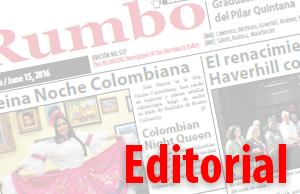
By José A. Ayala
The City of Lawrence was once again exposed to the nation and the rest of the world when President Donald Trump called the Immigrant City one of the main causes of the opioid crisis in the neighboring state of New Hampshire. Trump traveled to NH to reveal his plan to combat the deadly addiction to opioids.
During his appearance before supporters and local politicians at Manchester Community College on the afternoon of Monday, March 19, Trump told the audience that an offensive against sanctuary cities should be launched, such as “the neighboring Sanctuary City of Lawrence, Massachusetts, which, according to Dartmouth College in Hanover, NH, is one of the main sources of fentanyl that reaches six New Hampshire counties.
To support that, Trump introduced ICE agent Derek Dunn who worked with the State Police to uncover a major drug smuggling operation in Lawrence. Trump said the nation “must get tougher” on drug traffickers, and that includes using the death penalty. “These drug dealers will kill thousands of people during their lives… and they will only serve 30 days in prison… We have to get tougher with these individuals,” Trump said.
The mayor of Lawrence, Daniel Rivera, reacted on WBZ News Radio 1030 that the president lost the opportunity to face the problem of opioids instead of embarrassing a city like Lawrence.
Rivera said that out of everything the president talked about in his speech, none was in the commission’s report on how to eliminate the drug epidemic.
Certainly, the study cited by Trump was published last year by the Dartmouth Center for Technology and Behavioral Health (CTBH) of Dartmouth College in collaboration with the National Institute on Drug Abuse (NIDA) and the New Hampshire Democratic Congresswoman Annie Kuster.
According to the National Drug Threat Assessment conducted by the US Drug Enforcement Administration (DEA) in 2014, most of the supplies of heroin in the New England region are brought from New York along the vast interstate highway system, naming Interstates 95 and 93 as the main routes to traffic heroin to New Hampshire. This report from the DEA, mentioned in the Dartmouth College study, also names Lawrence, MA as the main distribution center for the northern states of New England.
Blaming Lawrence for the drug problems of the neighboring state of NH is not new. You will remember that a year ago, there was a war of words between the Governor of New Hampshire, Chris Sununu, and the mayor of Lawrence Dan Rivera, after Sununu said that the city of Lawrence was to blame for the growing opiate crisis in his state.
“It’s coming from Lawrence,” Sununu said in March 2017 at the Manchester Chamber of Commerce breakfast. “85 percent of fentanyl in this state comes directly from Lawrence, Massachusetts.”
He also pointed to Lawrence again in an interview later that day with the Boston Herald Radio in Boston, saying that the fact that Lawrence “is a sanctuary city” is causing problems for New Hampshire.
“Massachusetts also serves as a temporary stop or transit point for heroin that is transported to northern states,” the report says. “Lawrence and Lowell, north of Boston, are distribution centers for northern New England and Canada, Maine, New Hampshire and Vermont receive heroin mainly from distributors or dealers in northeastern Massachusetts, particularly Lawrence and Lowell.”
President Trump announced a new website – crisisnextdoor.gov – that warns about the dangers of opiates, including fentanyl.
In 2017, New Hampshire had the third highest rate of deaths from drug overdoses in the United States, according to the CDC.



